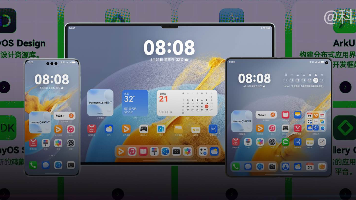#跟着若城学鸿蒙# 构建可交互的侧边栏式布局 —— SideBarContainer 实战
·
在多终端应用中,侧边栏(Sidebar)是常见的导航或功能区展现形式。ArkUI 的 SideBarContainer 组件,能够让你在室内设计模式(Embed)和覆盖模式(Overlay)之间轻松切换,并提供丰富的控制按钮定制能力。
一、组件简介
interface SideBarContainerInterface {
(type?: SideBarContainerType): SideBarContainerAttribute;
}
-
SideBarContainerType.Embed- 侧边栏始终与内容区并排显示,不会遮挡内容。
-
SideBarContainerType.Overlay- 侧边栏浮于内容区之上,可通过按钮或滑动手势控制显示/隐藏。
容器内必须添加两个子组件:
- 第一个子组件:侧边栏视图
- 第二个子组件:主内容视图
二、快速上手
下面示例展示了一个浮层(Overlay)侧边栏,点击按钮即可切换显示状态。
@Entry @Component
struct MySidebarApp {
@State showMenu: boolean = false;
build() {
SideBarContainer(SideBarContainerType.Overlay) {
// ——— 侧边栏区域 ———
Column() {
Text("菜单")
.fontSize(24)
.textAlign(TextAlign.Center)
.padding(20)
Button("关闭")
.onClick(() => this.showMenu = false)
}
.width(200)
.backgroundColor("#f0f0f0")
// ——— 主内容区域 ———
Column({ space: 12 }) {
Button(this.showMenu ? "隐藏侧边栏" : "显示侧边栏")
.onClick(() => this.showMenu = !this.showMenu)
Text("这是主内容区")
.fontSize(18)
.padding(10)
.backgroundColor("#ffffff")
}
.backgroundColor("#e8e8e8")
}
.showSideBar(this.showMenu)
.width("100%")
.height("100%")
}
}
showSideBar(...):绑定到@State showMenu,实现在浮层模式下的展开/收起控制。
三、核心属性
| 属性 | 说明 | 示例值 |
|---|---|---|
showSideBar |
布尔值,控制侧边栏显示/隐藏 | true / false |
controlButton |
自定义控制按钮样式 | ButtonStyle 对象 |
showControlButton |
是否展示控制按钮 | true / false |
sideBarWidth |
侧边栏宽度(px) | 180 |
minSideBarWidth |
侧边栏最小宽度 | 120 |
maxSideBarWidth |
侧边栏最大宽度 | 300 |
ButtonStyle 结构
declare interface ButtonStyle {
left?: number; // 相对于容器左侧的偏移
top?: number; // 相对于容器顶部的偏移
width?: number;
height?: number;
icons?: {
shown: string; // 展开图标
hidden: string; // 收起图标
switching?: string; // 切换时过渡图标
};
}
四、自定义控制按钮示例
在“嵌入模式”下,我们可以在侧边栏边缘放一个控制按钮,随时收起或弹出侧边栏:
@Entry @Component
struct EmbedSidebarDemo {
@State menuVisible: boolean = true;
build() {
SideBarContainer(SideBarContainerType.Embed) {
Column() {
Text("主导航")
.fontSize(20)
.padding(16)
}
.width(240)
.backgroundColor("#222")
Column() {
Text("应用内容")
.fontSize(18)
.padding(16)
}
.backgroundColor("#fff")
}
.showSideBar(this.menuVisible)
.sideBarWidth(240)
.controlButton({
left: this.menuVisible ? 240 - 24 : 0, // 当侧边栏收起时按钮贴左移入
top: 16,
width: 24,
height: 24,
icons: {
shown: "icon_collapse", // 假设已加载本地资源
hidden: "icon_expand"
}
})
.showControlButton(true)
.onChange((visible) => {
this.menuVisible = visible;
})
.width("100%")
.height("100%");
}
}
- 当侧边栏可见时,控制按钮位于侧边栏的右侧边缘;
- 收起后,按钮滑入内容区左侧,保持 24px 可点击区域。
五、事件回调
SideBarContainer(...)
.onChange((visible: boolean) => {
// visible = true:侧边栏展开
// visible = false:侧边栏收起
console.log("菜单当前状态:", visible);
});
可用于同步外部数据、统计用户行为,或伴随动画效果执行额外逻辑。
六、实战建议
-
模式选型
- Embed:适合桌面端或平板,侧边栏占据永久空间;
- Overlay:适合手机端,侧边栏可覆盖内容,不占用常驻布局空间。
-
宽度管理
- 选择合理的最小/最大宽度,防止内容过窄或占用过多屏幕。
-
图标资源
- 建议使用矢量或适应深色/浅色主题的图标,保证在不同背景下都清晰可见。
-
可访问性
- 控制按钮需留有足够的可点击面积(至少 44×44dp),并添加
aria-label或无障碍描述。
- 控制按钮需留有足够的可点击面积(至少 44×44dp),并添加
小结
SideBarContainer 将侧边栏常见的“嵌入式”与“浮层式”场景封装得很轻量,通过一行类型切换、几行属性配置,即可实现从桌面级导航到移动端抽屉的多样侧边栏交互。掌握它,你的 ArkUI 项目就再也不怕菜单体量大、屏幕空间窄的尴尬了。
更多推荐
 已为社区贡献86条内容
已为社区贡献86条内容









所有评论(0)